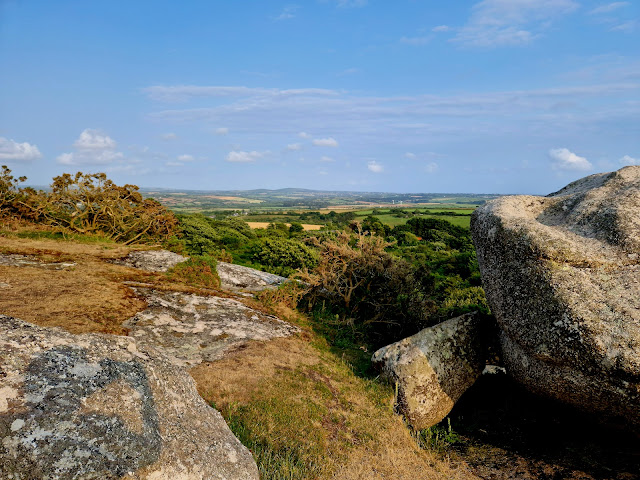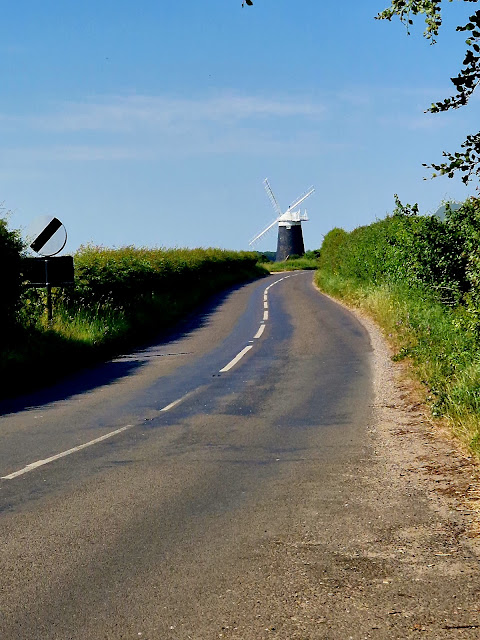GPX File Here.
On Monday the 3rd July 2023, I decided to drive a short distance from the St Ives Holiday Village run by John Fowler to the Trencrom Hill car park (TR27 6NP) to climb Trencrom Hill.
It was late evening so the sun was much cooler and was beginning to set, giving the area a nice glow.
Trencrom Hill (or Trecrobben) is a prominent hill fort, owned by the National Trust, near Lelant, Cornwall. It is crowned by an univallate Neolithic tor enclosure and was re-used as a hillfort in the Iron Age. Cairns or hut circles can be seen in the level area enclosed by the stone and earth banks. The hill overlooks the Hayle Estuary and river, and Mount's Bay and St Michael's Mount can be seen to the south. The hill was recorded as Torcrobm in 1758 which is derived from Cornish "torr crobm", i.e. 'hunched bulge'.
Trencrom Hill was acquired by the National Trust as freehold on 8 August 1946 from Lieutenant Colonel G L Tyringham. The freehold was 25.568 hectares (63.18 acres). On ascending the hill from the north side there is a plaque in situ in the rock facing the path. It reads:
"This property was presented to the National Trust by Lt Col C L Tyringham, of Trevethoe in March 1946 & at his wish is to be regarded as a memorial to the men and women of Cornwall, who gave their lives in the service of their country during the two world wars. 1914 – 1918, 1939 – 1945".
The well on the west side of the ramparts of the hill fort is known as the Giant's Well. James Halliwell-Phillipps mentioned it in 1861 in Rambles in Western Cornwall, "Outside the vallum at Trecrobben, or, as it is called by the rustics, Trancrom, is the Giant's Well". The well low down on the eastern flank of the hill is not the Giant's Well and is a disused shaft of the Praed Consols (Wheal Cherry/New Trencrom) sett, which was used as a well after the mine had flooded.
The hill began to rise a little more steeply towards the top and a little scramble up a coupe of high rocks.
The sett (area) of Wheal Cherry (later known as New Trencrom Mine and Mount Lane Mine) included the summit of Trencrom Hill. Trencrom is within the granite and the sett also covered the metamorphosed killas to the east. Wheal Cherry seems to have been short-lived with £2,293 spent on the erection of a 24-inch pumping engine and 24 inch whim with stamps in 1857/58 and by September 1858 the sett and materials being offered for sale. The sale notice stated that Wheal Cherry was ″a valuable property″. There was another attempt at the start of the 20th century by the Gerry Brothers of Lelant and after five years they sold their interest in 1907. At this time a new shaft was being sunk on the eastern slope and at a depth of 7 fathoms (42 ft; 13 m) found a 2 feet (0.61 m) wide lode which yielded 60 pounds (27 kg) of black tin to the ton. Work was still continuing on Wheal Cherry in 1916. A further attempt in 1943 at the mine, now known as the Mount Lane Mine was unsuccessful.
A survey in January 1996 found small scale quarrying, mostly post-medieval using drills but in some cases using wedges which may be earlier. Large parts of the granite summit have been levelled and a paved track was probably used to transport stone from the quarry face on carts.
I reach the top (175m) with views across to Carbis Bay.
Trecobben, the giant of Trencrom, was supposed to have killed Cormelian (wife of Cormoran) by throwing a hammer across to St Michael's Mount.
In several parts of Cornwall there are evidences that these Titans were a sportive race. Huge rocks are preserved to shew where they played at trap-ball, at hurling, and other athletic games. The giants of Trecrobben and St Michael’s Mount often met for a game at bob-buttons. The Mount was the “ bob,” on which flat masses of granite were placed to serve as buttons, and Trecrobben hill was the “mit,” or the spot from which the throw was made. This order was sometimes reversed. On the outside of St Michael’s Mount, many a granite slab which had been knocked off the “ bob ” is yet to be found; and numerous piles of rough cubical masses of the same rock, said to be the granite of Trecrobben Hill,* shew how eagerly the game was played.
Trecrobben Hill was well chosen by the giants as the site of their castle. From it they surveyed the country on every side; and friend or enemy was seen at a considerable distance, as he approached the guarded spot. It is as clear as tradition can make it, that Trecrobben was the centre of a region full of giants.
 |
| View across to St Michaels Mount |
St Michael's Mount may have been the site of a monastery from the 8th to the early 11th centuries. Edward the Confessor gave the site to the Benedictine order of Mont-Saint-Michel and it was a priory of that abbey until the dissolution of the alien houses as a side-effect of the war in France by Henry V. Subsequently, it ceased to be a priory, but was reduced to being a secular chapel which was given to the Abbess and Convent of Syon at Isleworth, Middlesex, in 1424.Thus ended its association with Mont-Saint-Michel, and any connection with Looe Island (dedicated to the Archangel Michael). It was a destination for pilgrims, whose devotions were encouraged by an indulgence granted by Pope Gregory in the 11th century. The earliest buildings on the summit, including a castle, date to the 12th century.
There are views stretching across North Cornwall to Godrevy and towards Rosewall Hill to the west.
THE SPRIGGANS OF TRENCROM HILL.
IT is not many years since a man, who thought he was fully informed as to the spot in which a crock of the giant's gold was buried, proceeded on one fine moonlight night to this enchanted hill, and with spade and pick commenced his search. He proceeded for some time without interruption, and it became evident to him that the treasure was not far off. The sky was rapidly covered with the darkest clouds, shutting out the brilliant light o the moon--which had previously gemmed each cairn--and leaving the gold-seeker in total and unearthly darkness. The wind rose, and roared terrifically amidst the rocks; but this was soon drowned amidst the fearful crashes of thunder, which followed in quick succession the flashes of lightning. By its light the man perceived that the spriggans were coming out in swarms from all the rocks. They were in countless numbers; and although they were small at first, they rapidly increased in size, until eventually they assumed an almost giant form, looking all the while, as he afterwards said, "as ugly as if they would eat him." How this poor man escaped is unknown, but he is said to have been so frightened that he took to his bed, and was not able to work for a long time.
Keep an eye out for holes in the summit's boulders. These were drilled by miners during the Victorian times and on Midsummer's Day the merrymakers would fill the holes with gunpowder and light the fuses in celebration.
"On the largest of these cairns are some rock-basins, known respectively as the Giant's Chair, the Giant's Cradle, and the Giant's Spoon.
I descend back down to the bottom and the car.
Only a short walk but a great hill at sunset. I walked this again later ion the week with my kids. We walked from St Ives Holiday Village up a very busy road (Not advisable) and then after maybe a mile we took a footpath on our left and this immediately begins to climb steeply. We reach another road which we cross and walk up the path to the summit. We decide to descend the hill on the side of my previous trip and down to the car park and follow this quiet road back to the site.







































































































